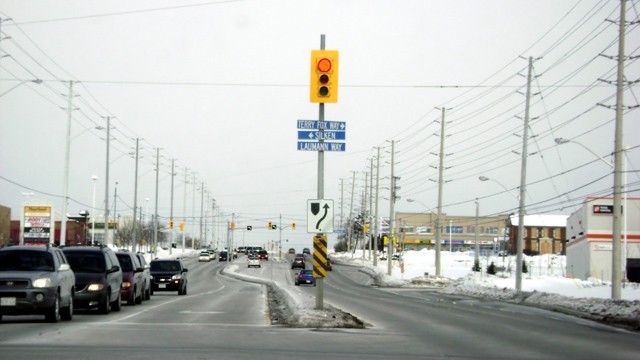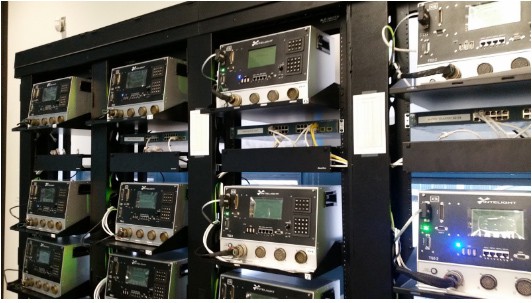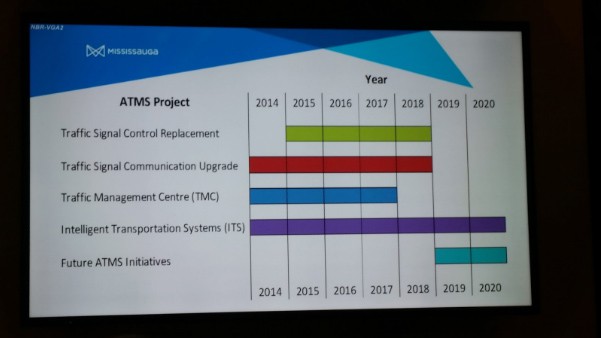Mississauga Launching Brand New Traffic Control System
Published February 8, 2017 at 6:51 pm

In the last few municipal election cycles, local politicians have frequently campaigned on the need to end the ‘war on the car,’ saying that commuters have been pulled to the brink. But perhaps they should focus more on a ‘war on congestion,’ as that is the primary cause of constant traffic jams.
If you’re looking to have a ‘war on congestion’ then you should think about how to stop a problem before it starts. How do you proactively deal with the issue of traffic congestion rather than just react when things happen? How do you make sure traffic lights aren’t just stuck changing at a fixed interval if a situation arises that requires traffic to flow quickly through a certain intersection?
In order to showcase what Mississauga is doing to tackle this problem, the city hosted a media open house at the new Advanced Transportation Management System (ATMS) at 3185 Mavis Road, just across from the Mississauga Flea Market and the Enersource building. Mississauga is implementing this state-of-the-art system to better respond to changing traffic conditions and adjusting traffic signals. The new system will better integrate with various levels of government and agencies and will keep Mississauga moving more seamlessly.
Through the ATMS, Mississauga is looking to accomplish the following goals:
- Maximizing the available capacity of the roadway network.
- Minimize the impact of roadway incidents to everyday users.
- Pro-actively manage traffic situations.
- Assist in the provision of emergency services.
- Create and maintain public confidence in traffic management.
The main presentation about the ATMS was conducted by Mickey Frost, the director of transportation, works, operations and maintenance and Shawn Slack, the director of information technology. They outlined the main project components, and their entire Powerpoint presentation can be found here. Here is what they outlined and some of my own thoughts on some of the project components.
Build a Traffic Management Centre
According to Frost, the first step was to design and construct a physical central space where traffic staff can monitor and respond to traffic. This component of the project is substantially complete. It’s not that they built an entirely new facility; it’s more like renovating the existing traffic management centre at 3185 Mavis Road.
The screens not only have a live feed from CP24 and the weather channel but also the Compass feed from the Ministry of Transportation (MTO), as well as monitors to see if the traffic lights are working, which is the main big screen in the middle. Overall, the city will definitely need some kind of space to coordinate all these activities and it’s fortunate they had existing space rather than having to construct an entirely new facility.
Traffic Signal Communications
As of right now, some 120 traffic signals have migrated to the new network, and the remaining signals will be completed by the end of 2018. There are some 750 intersections that require an upgrade of not only signals, but also a combination of fibre optics, Wifi and cellular networks.
The mention of Wifi and fibre optics may have you asking…well, can this thing be hacked? It’s not like the ATMS is immortal; there is a finite life cycle. But the staff there assured us that the system is good for up to 10 years, with upgrades in between, so the hardware may be more stable but the software would require upgrades based on changing circumstances. One comparison was on a scale between 1 (a baby could hack into it) and 10 (it’s impossible to hack), the ATMS representatives were quite confident that the system is at a 10.
Traffic Control System Replacement
So this component is about replacing the traffic control system not only in the command centre, but the traffic signal controllers in the field. I took some pictures of the current pieces of equipment that they use to control the signals, and it’s a good thing too. These things looked like they were left over from the 50s during the height of the Cold War.

By replacing these old machines, the ATMS seeks to do the following:
- The ability to accommodate future modules and technology advancements (for example, traveller information).
- The ability to share information with the Region of Peel, MTO and neighbouring municipalities. The live feed of CP24 and using the MTO’s own feed gives an indication they’re using information that is commonly referenced across the GTA.
- Ability to integrate with Mississauga Transit and Fire, which will be crucial to allow emergency vehicles to get around Mississauga during an emergency.
- Use the City’s network to communicate to Traffic Signal Controllers and other devices (ex. traffic cameras). This feeds into the concept of the ‘smart city.’
- Pro-actively manage traffic signals, going back to the notion of stopping a problem before it starts.
- Intelligent Transportation Systems (ITS)
The staff and elected officials have really bought into this notion of the ‘smart city’. The new monitors for ATMS is technology known as Intelligent Networks (or INET) according to Al Sousa, the manager of traffic control. The ITS will use smart technologies, such as cameras monitoring high profile corridors. Currently the city has 38 of those set up and the long term goal is to get 150 cameras throughout Mississauga. They are also looking into piloting new detection tech such as radar to detect not only vehicles, but bicycles and pedestrians.
So to make sure that this component is sound, the ATMS is planning to conduct some tests. A demonstration is set to take place along Dundas Street, from Ninth Line to Mississauga Road, with the goal of testing various traffic management technologies. The plan calls for the testing to take place this year, so if you’re driving along Dundas Street and notice some workers or technicians doing something you don’t quite understand, it’s probably the ATMS guys testing their new toys.
Future ATMS Initiatives
So this is the part where Mississauga will be keeping an eye on current trends and technological developments. Insauga asked how autonomous (self-driving) vehicles factor into this new system. The ATMS representatives indicated they are aware of future smart technologies to ensure the system has the ability to incorporate new technologies like autonomous vehicles and other advancements. It’s based on the concept of Open Architecture.
Perhaps in the future we could see a Mississauga refrain from using traffic lights at all when it comes to autonomous vehicles because they will manage to use the ATMS to time things so perfectly, as this video depicts:
For the average Mississauga resident and driver, you must be wondering how much does all this fancy technology cost. Overall, they are looking to invest a total of $16.2 million for the completion of the project by end of 2020. Their timeline is shown below:

So by the end of the 2018, the bulk of the ATMS (the command centre, replacing the traffic signals) should be up and running, and that’s good because the bulk of those projects focus on the immediate needs of managing traffic lights. The other initiatives will eventually be phased in a few years later.
According to Al Sousa, the Manager of Traffic Control for the ATMS, they also hired eight people between 2014 to 2017. These eight positions consisted of four ATMS operators and four technical staff approved through the operating budgets over 2014 to 2017. These operating budgets are not part of the $16.2 million.
Speaking of that $16.2 million, Sousa indicated that there will possibly be additional budget requests based on the pilot testing they conduct along Dundas. Pending the results of those pilots, they can determine what else they need and go back to Council with a business case.
So basically, yes this is probably going to cost more than the allocated $16.2 million. But my impression of the ATMS was that it was quite state of the art, and once it’s fully up and running it should accomplish the objectives of making Mississauga move more seamlessly than before.
I’d rather have something that prevents traffic problems before they start, don’t you?
INsauga's Editorial Standards and Policies
